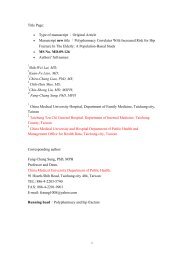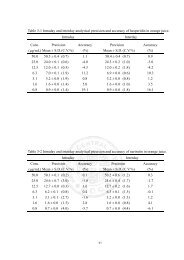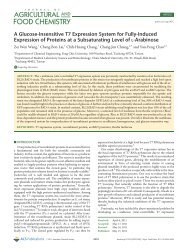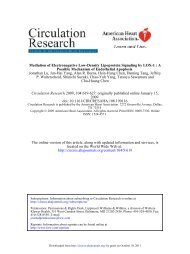Culinary Narratology in Everyday Life: Foodways and Identity ...
Culinary Narratology in Everyday Life: Foodways and Identity ...
Culinary Narratology in Everyday Life: Foodways and Identity ...
Create successful ePaper yourself
Turn your PDF publications into a flip-book with our unique Google optimized e-Paper software.
<strong>Cul<strong>in</strong>ary</strong> <strong>Narratology</strong> 14<br />
food. In analyz<strong>in</strong>g ethnic cul<strong>in</strong>ary praxis, Herbert Gans postulates the elaborate relationship<br />
between immigrant foodways, ethnicity <strong>and</strong> identity formation as “expressive” <strong>and</strong><br />
“symbolic” (436). Accord<strong>in</strong>g to his argument, <strong>in</strong> consum<strong>in</strong>g particular k<strong>in</strong>ds of ethnic foods,<br />
immigrants are able to immerse themselves <strong>in</strong> connect<strong>in</strong>g to their cultural traditions without<br />
be<strong>in</strong>g forced to <strong>in</strong>corporate themselves <strong>in</strong>to their everyday behavior. However, Anita<br />
Mannur has the opposite view, argu<strong>in</strong>g that immigrants’ desire to consume certa<strong>in</strong> ethnic<br />
foods actually represents how they deliberately <strong>in</strong>tend to racialize themselves <strong>in</strong> particular<br />
<strong>and</strong> powerful ways (58). Thus, eat<strong>in</strong>g can serve as a performative act for immigrants as well<br />
as an important site of resistance.<br />
Read<strong>in</strong>g cul<strong>in</strong>ary practices as a performative act of resistance relies not only on the<br />
symbolic, but also the material qualities of food, as well as the ways food represents <strong>and</strong><br />
performs the solidity <strong>and</strong> materiality of the body. The association between what a person<br />
eats <strong>and</strong> identifies with is always reiterated <strong>and</strong> reconstructed by daily quotidian acts.<br />
Therefore, through the act of consum<strong>in</strong>g particular foods, bodies can become social be<strong>in</strong>gs<br />
that literally embody certa<strong>in</strong> k<strong>in</strong>ds of consciousness, such as a sense of nationality or<br />
ethnicity. In analyz<strong>in</strong>g the <strong>in</strong>teractions between foodways <strong>and</strong> ethnic identity formations,<br />
Jennifer Ho argues that food serves as a significant medium for compliance with <strong>and</strong><br />
resistance to Americanization (3). Cook<strong>in</strong>g, eat<strong>in</strong>g, <strong>and</strong> choices of <strong>in</strong>gredients consequently<br />
become explicitly political acts of resistance <strong>in</strong> demarcat<strong>in</strong>g boundaries of either <strong>in</strong>clusion or<br />
exclusion <strong>and</strong> affirmation or negation with<strong>in</strong> an imag<strong>in</strong>atively constructed home <strong>in</strong> diasporic<br />
lives. For the female immigrants <strong>in</strong> Lahiri’s works, cul<strong>in</strong>ary practices may be considered as<br />
routes toward the racialization of their characters <strong>in</strong>to gender <strong>and</strong> class conventions. In<br />
addition, food <strong>and</strong> eat<strong>in</strong>g also reveal what is imag<strong>in</strong>ed as l<strong>in</strong>guistically impossible, gestur<strong>in</strong>g<br />
towards what is outside social discourse <strong>and</strong> forms of embodied knowledge that lurk at the<br />
limits of textual possibility. In Mrs. Sen’s case, as she is silenced by her husb<strong>and</strong> <strong>and</strong> the<br />
normaliz<strong>in</strong>g <strong>in</strong>fluence of American society, the only way she can express herself is through









